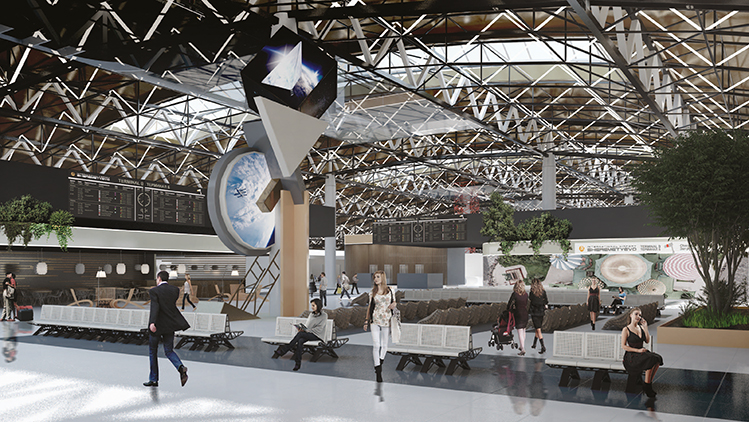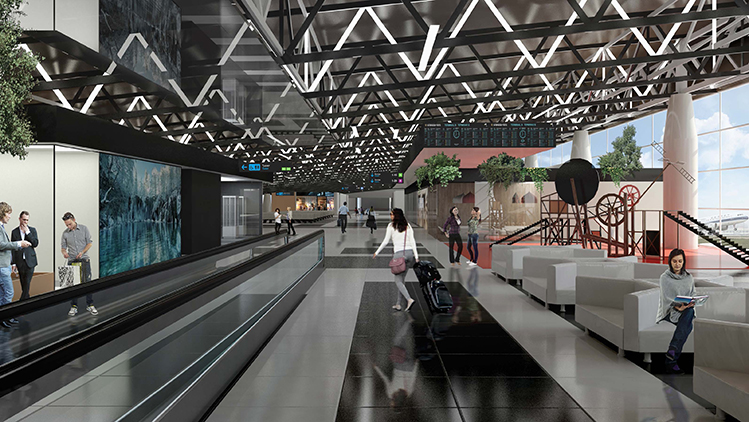Visitors to next year’s FIFA World Cup, hosted by Russia, will experience a redeveloped Sheremetyevo International Airport. At the heart of the modernisation is the new $305 million (€260m) Terminal B in the airport’s Northern Terminal Complex. The 114,000sqm facility will have a capacity of 20 million passengers per year.

Jelena Nikolic, RMJM Serbia’s lead architect: “Our proposal based on avant-garde Russian Constructivism combines technology and tradition, past and future, culture and efficiency, transforming the terminal into a door through which Russia can tell its story and welcome the world.”
“The FIFA World Cup will attract hundreds of thousands of people to the country and, for most of them, their Russian experience will begin at Sheremetyevo Airport. So, when TPS first approached us to design the interior of Terminal B, we immediately understood that we had to come up with something unique,” says Jelena Nikolic, RMJM Serbia’s lead architect. “The brief asked for a design which could support an incredible increase in the passenger flows while showcasing the real soul of Russia and leaving an impression on the passengers flying into and through Sheremetyevo Airport. Our proposal based on avant-garde Russian Constructivism combines technology and tradition, past and future, culture and efficiency, transforming the terminal into a door through which Russia can tell its story and welcome the world.”
It was a concept so well received that the client asked RMJM to design other areas at Sheremetyevo, including two inter-terminal stations, the Terminal B facade, and terminal buildings C1 and C2.
As Nikolic explains, the RMJM team drew inspiration from Russian Constructivism – a seminal art movement in the early 20th century. “Everything, from the space organisation to the geometric forms and palette used in our design for Terminal B, C1, C2 and the inter-terminal stations, is based on the work of renowned Constructivist artists such as Vladimir Tatlin, Nahum Gabo, Alexandra Vesnina, Alexander Rodchenko, El Lissitzky and Liubov Popova,” she says. “In the interior, the floors recall the graphic design and photos of Alexander Rodchenko, while the design of the aircraft at the Northern Terminal was inspired by Yakov Chernikhov’s drawings as visible in the top view of the composition scheme. The oblique columns of Terminals B and C2, that spread out like the wings of the central Terminal C, support canopies inspired by Naum Gabo’s painting, Kinetic sculpture. In fact, every detail is inspired by this avant-garde.”

The RMJM team drew inspiration from Russian Constructivism – a seminal art movement in the early 20th century. “Everything, from the space organisation to the geometric forms and palette used in our design for Terminal B, C1, C2 and the inter-terminal stations, is based on the work of renowned Constructivist artists,” explains Jelena Nikolic, RMJM Serbia’s lead architect.
Indeed, art is integrated with cutting-edge technology throughout the terminal to shape the space around the movement of passengers. “A clear example of this is the clock in the Northern Terminal station,” Nikolic comments. “Another example is the two LED-screens sculpture that recreates El Lissitzky’s illustration in three dimensions. The two screens, one circular and one cubic on top of the composition, are synchronised to create a unique media story.”
The design truly creates a sense of place, with the Northern Terminal Complex offering passengers a seamless design experience, both inside and outside the buildings. The two inter-terminal stations maintain the Constructivist flavour, with RMJM concentrating its attention on the work and unique relationship of two eminent Constructivist artists, Liubov Popova and Varvara Stepanova, whose collaboration reached its peak at the Vhutemas Art Institute and in their textile design for Tsindel, the first state textile factory in Russia. “Much like the artists whose work this project references, we wanted the two stations to be different but visually connected through a gradient effect. We have referred on their work on the patterns on the wall and floor covering design. It addresses the Terminal B interior, yet provides a different ambience,” Nikolic explains. “What I love most about this project is that it allowed us to work on the general concept and bring these ideas closer to the people, while paying our deepest respect to Russia. It was not an easy process, but it is very rewarding to see the results come to life.”

The brief for the new Terminal B in Sheremetyevo’s Northern Terminal Complex asked for a design which could support an incredible increase in the passenger flows while showcasing the real soul of Russia and leaving an impression on the passengers flying into and through Sheremetyevo Airport.







